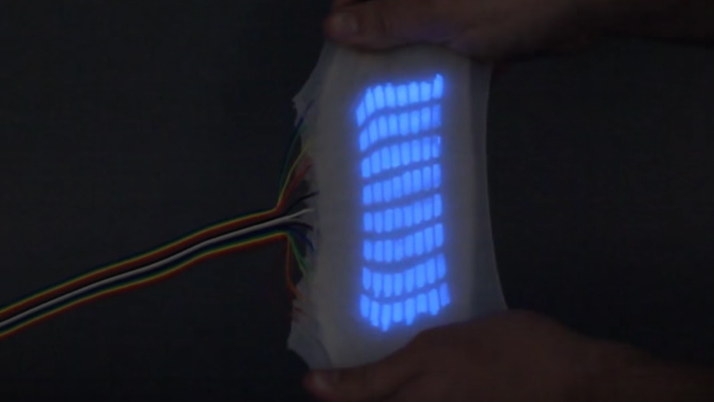This stretchy octopus-like skin will help us befriend robots

That strange-looking piece of material above? It's a piece of stretchy artificial skin which is capable of emitting light and sensing pressure, and could one day be used on robots and other electronics.
A team of scientists at Cornell University created the skin using hyperelastic, light-emitting capacitors - or HLECs - that can continue to shine when being stretched, resulting in a rollable, flexible display.
Octopuses are capable of changing color and texture to match their surroundings, which is idea behind Cornell's flexible display. According to the researchers, the skin can currently be stretched to five times its original size.
There are a number of possible applications, but perhaps its most interesting use case would be robots. While that might sound a little scary, it should, in theory, have the complete opposite effect.
"We can take these pixels that change color and put them on these robots, and now we have the ability to change their color," said Robert Shepherd, who led the team of roboticists. "Why is it important? For one thing, when robots become more and more a part of our lives, the ability for them to have emotional connection with us will be important.
"So to be able to change their color in response to mood or the tone of the room we believe it going to be important for human-robot interactions."
Considering the research was past funded by the Army and Air Force, we could also one day seen this use as a more advanced type of camouflage.
Sign up for breaking news, reviews, opinion, top tech deals, and more.
Beyond robots, Shepherd suggests that the technology could be used on smartphones that could be stretched to the size of a tablet. Wearables seem another obvious area where stretchy flexible displays could be useful.
You can read more about the research here, and find the original paper in Science.

Hugh Langley is the ex-News Editor of TechRadar. He had written for many magazines and websites including Business Insider, The Telegraph, IGN, Gizmodo, Entrepreneur Magazine, WIRED (UK), TrustedReviews, Business Insider Australia, Business Insider India, Business Insider Singapore, Wareable, The Ambient and more.
Hugh is now a correspondent at Business Insider covering Google and Alphabet, and has the unfortunate distinction of accidentally linking the TechRadar homepage to a rival publication.